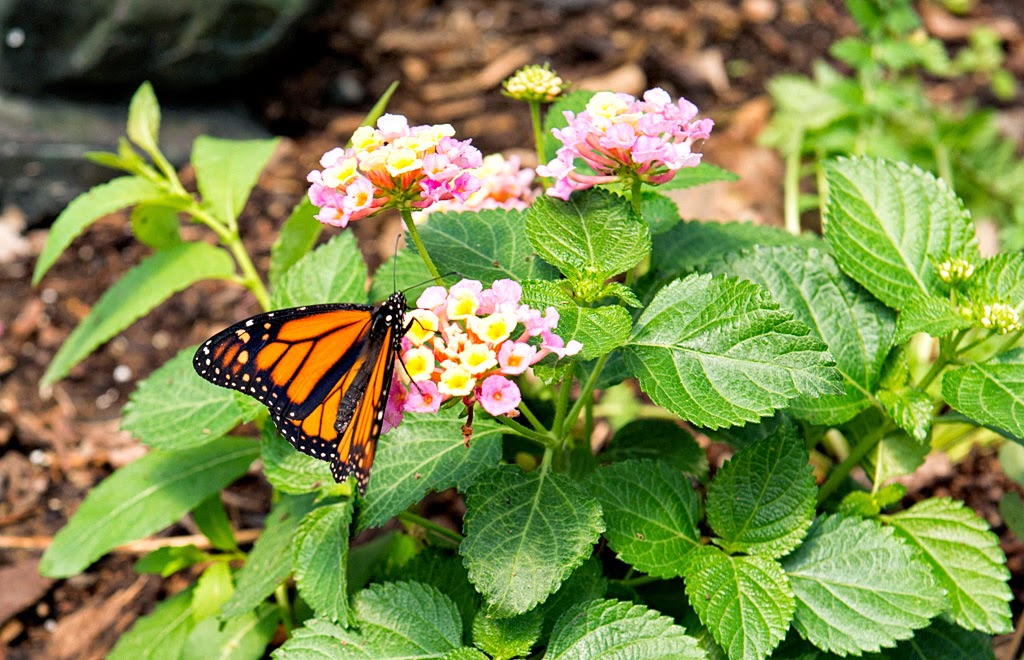“Oh my dear love is so fragile but also very beautiful ... just like a
butterfly . Promise me you never put your heart in the hands of savage ,
but instead give it to another butterfly .”
-Dagmar D.l.R
Summer is well on its way now, as the latest photos below of the container garden attest. There is a constant flow of new and emerging Monarch caterpillars, coupled with a population explosion of oleander aphid on the milkweed.
No worries mate, as they are host specific just as the caterpillars are. Yes, they are ugly, and yes, they can literally cover a plant's stems, but they don't seem to affect their hosts too much; there are plenty of leaves to be had for the munching by Monarch caterpillars.
The only plants I've lost to aphids were those that were already weak for whatever reason. They would have eventually succumbed without the help of the aphids anyway.
Margot Norris of Laguna Beach, California informed me that she just found six Monarch cats on her Tropical Milkweed plant. Congrats Margot! As the season progresses Margot, and if you get bit by the Monarch caterpillar bug, you will need to buy more milkweed in order to satisfy the voracious appetites these striped hotdogs with legs require.
SPEAKING OF MILKWEED...
Margot Norris of Laguna Beach, California informed me that she just found six Monarch cats on her Tropical Milkweed plant. Congrats Margot! As the season progresses Margot, and if you get bit by the Monarch caterpillar bug, you will need to buy more milkweed in order to satisfy the voracious appetites these striped hotdogs with legs require.
SPEAKING OF MILKWEED...
There have been reports on a Facebook page of people purchasing milkweed at their local Home Depot, only to have their Monarch caterpillars croak after feeding on them (copied from Facebook Monarch Butterfly Garden page):
That's not to disparage Home Depot; others have bought milkweed plants there without the resultant cat mortality. Basically, buy from a reputable source that will guarantee their milkweed plants to be pesticide free. Ask first before purchasing. Although the nursery personnel may say they don't spray pesticides on their milkweed, their supplier or suppliers may. Locally, Butterfly Farms of Vista, California specifically raises host and nectar plants that are pesticide free with butterflies in mind .
I'm sure there were Anise Swallowtail cats in the fennel. I can't find any, but several days ago I noticed that the fennel plants were all disheveled. Looking closer, I did find tiny caterpillar frass in some of the leaf crotches, but no cats. The assumption is that a larger bird - most likely crows - spotted them and had a heyday with the cats in the plants (sounds like a Dr. Seuss book). As Charlie Brown would say, "Aaugh!"
A Cautionary Tale that Bears Repeating:
From MBG Community Member Wendy: "Please warn everyone The Home Depot is selling milkweed with pesticides. A friend and I bought tropical milkweed plants, and transferred our caterpillars to these pl... See More
From MBG Community Member Wendy: "Please warn everyone The Home Depot is selling milkweed with pesticides. A friend and I bought tropical milkweed plants, and transferred our caterpillars to these pl... See More
That's not to disparage Home Depot; others have bought milkweed plants there without the resultant cat mortality. Basically, buy from a reputable source that will guarantee their milkweed plants to be pesticide free. Ask first before purchasing. Although the nursery personnel may say they don't spray pesticides on their milkweed, their supplier or suppliers may. Locally, Butterfly Farms of Vista, California specifically raises host and nectar plants that are pesticide free with butterflies in mind .
I'm sure there were Anise Swallowtail cats in the fennel. I can't find any, but several days ago I noticed that the fennel plants were all disheveled. Looking closer, I did find tiny caterpillar frass in some of the leaf crotches, but no cats. The assumption is that a larger bird - most likely crows - spotted them and had a heyday with the cats in the plants (sounds like a Dr. Seuss book). As Charlie Brown would say, "Aaugh!"
 |
| © Charles Shulz |
 |
| © Andrew Kliss |
 |
| © Andrew Kliss |
 |
| © Andrew Kliss |
Large empty tubs waiting for their plants to get larger before planting.
 |
| © Andrew Kliss |



























